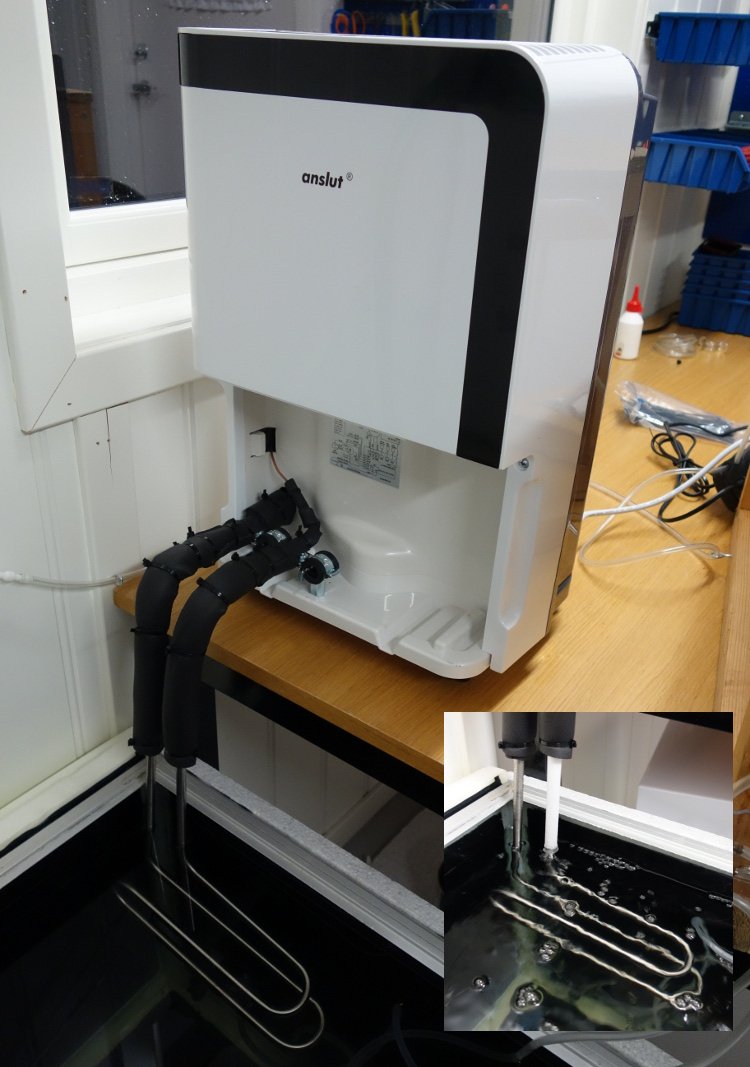Build your own aquarium chiller by removing heat sources, changing locations, using evaporative cooling, adding insulation, or purchasing a chiller.
:strip_icc()/chillerdon3-56a81add3df78cf7729c25b4.jpg)
Introduction To Aquarium Chillers
Discover how to construct your own aquarium chiller with these DIY plans, providing you with the tools to regulate and maintain the ideal temperature for your marine aquarium without the need for expensive equipment.
Aquarium chillers are essential equipment for maintaining the optimal temperature of your aquarium water. Whether you have a freshwater or marine aquarium, controlling the temperature is crucial for the well-being of your fish and other aquatic inhabitants. In this section, we will explore the basics of aquarium chillers, including what they are, why they are necessary, and the different types available on the market.
What Is an Aquarium Chiller?
An aquarium chiller is a device that helps regulate and lower the temperature of your aquarium water. It works by extracting heat from the water and dispersing it outside the tank, ensuring that the water remains at a suitable temperature for your aquatic life. Similar to how an air conditioner cools the air in your home, an aquarium chiller cools down the water in your tank, creating a comfortable and stable environment for the inhabitants.
Why use an aquarium chiller?
- Temperature Regulation: Maintaining the correct temperature is essential for the health and well-being of your fish and aquatic plants. Extreme temperatures can lead to stress, diseases, or even mortality.
- Preventing Heat Stress: In hot climates or during the summer months, aquarium water can heat up quickly. An aquarium chiller helps prevent heat stress by keeping the water temperature within the ideal range.
- Marine Aquariums: Certain marine species, such as corals and reef-dwelling fish, require specific temperature ranges to thrive. An aquarium chiller ensures that these delicate ecosystems remain in optimal conditions.
- Summer Heat: Even in air-conditioned rooms, aquarium water temperatures can rise due to ambient heat. An aquarium chiller acts as a dedicated cooling system, providing consistent temperature control regardless of external factors.
Types Of Aquarium Chillers
| Type | Description |
|---|---|
| Water Chillers | These are the most common types of aquarium chillers that use a refrigeration cycle to cool the water passing through them. |
| Peltier Chillers | These compact and energy-efficient chillers use Peltier modules to transfer heat away from the water. |
| Glycol Chillers | Primarily used in larger setups or for commercial purposes, glycol chillers use a refrigeration system to cool a separate coolant (usually glycol), which then cools the aquarium water through a heat exchanger. |
By understanding the different types of aquarium chillers, you can choose the one that best suits your aquarium size, budget, and cooling requirements.
Diy Aquarium Chiller
Are you tired of constantly worrying about keeping your aquarium cool? With a DIY aquarium chiller, you can easily regulate the temperature and create a comfortable environment for your marine life. Building your own chiller not only gives you more control over the cooling process but also allows you to save money. In this article, we will guide you through the step-by-step process of building your own aquarium chiller.
Benefits Of Building Your Own Chiller
- There is no need to rely on commercial aquarium chillers, saving you both money and the hassle of purchasing a pre-made one.
- Ability to customize the chiller according to your specific tank size and cooling needs.
- Greater control over the cooling process, ensuring the optimal temperature for your marine life.
- Satisfaction of creating a DIY project that adds a personal touch to your aquarium setup.
Materials And Tools Needed
To get started on building your DIY aquarium chiller, you will need the following materials and tools:
| Materials | Tools |
|---|---|
| Peltier cooling module | Screwdriver |
| Heat sinks | Soldering iron |
| Fan | Wire strippers |
| Thermal paste | Multimeter |
| Power supply | Plastic tubing |
| Insulation material | Cutting tool |
Step-by-step Instructions
- Start by carefully reading the manufacturer’s instructions for the Peltier cooling module.
- Prepare the heat sinks by applying a thin layer of thermal paste to one side.
- Attach the Peltier cooling module to one heat sink using screws.
- Connect the fan to the other side of the Peltier module using wire strippers.
- Secure the heat sinks with the attached peltier module and fan to the plastic tubing, creating a closed loop.
- Use a multimeter to check the voltage and ensure everything is properly connected.
- Cut the insulation material to fit around the plastic tubing, preventing heat exchange with the surroundings.
- Power up the DIY aquarium chiller and carefully monitor the temperature to adjust settings if necessary.
By following these step-by-step instructions and utilizing readily available materials, you can create your own DIY aquarium chiller, providing a controlled cooling system for your marine life. Enjoy the benefits of saving money, customization, and greater control over the well-being of your aquarium inhabitants.
Alternative Methods To Cool Your Aquarium
When it comes to maintaining a healthy and comfortable environment for your aquarium inhabitants, proper temperature control is crucial. While investing in a commercial aquarium chiller is a popular option, there are alternative methods that can effectively cool your aquarium without breaking the bank. In this article, we will explore three alternative cooling options that you can consider for your aquarium.
Removing Heat Sources
To effectively cool your aquarium, the first step is to identify and remove any unnecessary heat sources. This can include equipment such as heaters, UV sterilizers, skimmers, and hot lights. By eliminating these heat-producing devices, you can significantly reduce the overall temperature of your aquarium.
Additionally, consider changing the location of your aquarium. Placing it in a cooler area of your home or away from direct sunlight can help prevent excessive heat buildup. Proper ventilation around the aquarium is also important, as it allows for better air circulation and heat dissipation.
Using Evaporative Cooling
Evaporative cooling is another effective method to lower the temperature of your aquarium water. By utilizing the principle of evaporation, you can harness the cooling effect it produces.
One way to implement evaporative cooling is by positioning a fan near your aquarium to blow across the surface of the water. This promotes evaporation, which cools the water as a result. It is important to note that you may want to lower the water level slightly to prevent fish from jumping out.
Another option is to use an aerator in conjunction with a fan. This combination increases the surface area exposed to the moving air, enhancing the cooling effect. The increased oxygenation provided by the aerator also benefits your aquarium inhabitants.
Other Cooling Options
If the above methods do not provide sufficient cooling for your aquarium, there are other options you can explore.
One alternative is to add insulation to your aquarium. This can be done by applying a layer of insulation material, such as styrofoam, to the sides and bottom of the tank. Insulation helps to prevent the transfer of heat from the surroundings into the aquarium, keeping the water temperature more stable.
An additional option is to use a DIY aquarium chiller. Building your own chiller requires some technical expertise, but it can be a cost-effective solution. There are plenty of online resources and tutorials available to guide you through the process of constructing your own chiller using materials readily available on the market.
Finally, if all else fails, investing in a commercial aquarium chiller may be worth considering. While they can be more expensive compared to the alternative methods mentioned above, they offer precise temperature control and are designed specifically for aquarium use.
In conclusion, when it comes to cooling your aquarium, exploring alternative methods can be a practical and budget-friendly approach. By implementing these methods, you can ensure a comfortable and healthy environment for your aquatic pets without necessarily relying on a commercial aquarium chiller.


Frequently Asked Questions Of How To Build Your Own Aquarium Chiller
How To Build Your Own Chiller?
To build your own chiller, follow these steps: 1. Remove unnecessary equipment like heaters and UV sterilizers to reduce heat sources. 2. Open the aquarium cover and position a fan to blow across the water’s surface. 3. Use evaporative cooling by combining the fan with an aerator.
4. Add insulation to help maintain cooler temperatures. 5. Consider purchasing a chiller if these methods aren’t sufficient.
How Do I Make My Fish Tank Water Colder?
To make your fish tank water colder, you can: 1. Remove heat sources like heaters, UV sterilizers, and hot lights. 2. Change the location of the tank to a cooler area. 3. Use evaporative cooling by placing a fan near the tank.
4. Add insulation to keep the water temperature stable. 5. Consider buying a chiller for better temperature control. Keeping the aquarium cool without a chiller can be done by opening the tank cover and using a fan to blow across the water surface.
Combining this with an aerator helps in maintaining optimal temperature. Aquarium chillers are worth it as they keep the inhabitants comfortable and reduce heat from pumps and lights.
How Can I Cool My Aquarium Down Without A Chiller?
You can cool your aquarium without a chiller by opening the cover and placing a fan to blow across the water’s surface. You can also lower the water level an inch or two and use an aerator. Removing heat sources and adding insulation can also help.
Are Aquarium Chillers Worth It?
Yes, aquarium chillers are worth it as they help maintain a comfortable temperature for your aquarium inhabitants and can reduce heat generated by pumps and lights.
Conclusion
Building your own aquarium chiller can be a rewarding and cost-effective solution to maintaining the proper temperature in your marine aquarium. By following the step-by-step instructions and utilizing DIY plans, you can create a chiller that meets your specific needs.
Not only will this help keep your aquarium inhabitants comfortable and healthy, but it can also reduce heat generated by pumps and lights. With careful preparation and the right tools, you can enjoy the benefits of a homemade aquarium chiller.

